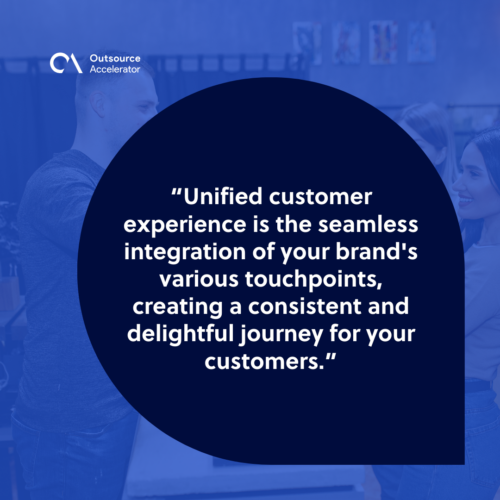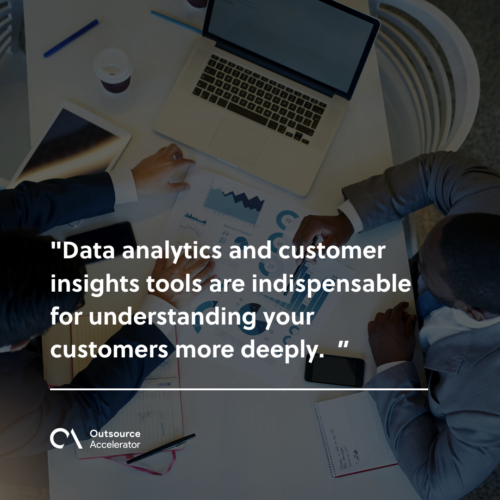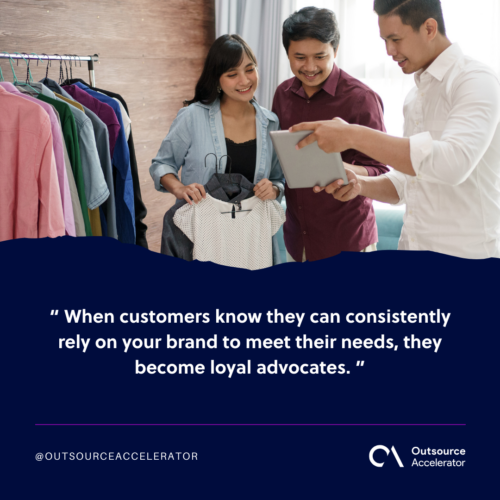Defining and creating a unified customer experience

Customer experience reigns supreme. To stand out and thrive, your brand must deliver a seamless, consistent, and delightful collective customer experience.
This article will explore unified customer experience, why it’s vital, and how to craft it for your business.
What is a unified customer experience?
Imagine stepping into a charming coffee shop. The barista greets you by name, knows your favorite brew, and even asks about your recent trip.
This encounter is a slice of the unified customer experience. It’s about treating your customers like cherished friends rather than mere transactions.
Unified customer experience is the seamless integration of your brand’s various touchpoints, creating a consistent and delightful journey for your customers.
Whether they engage with your business in-store, online, or via social media, they should feel like they’re interacting with a singular entity, not separate departments.

Components of unified customer experience
Unified customer experience relies on several crucial components that work together to create a seamless and delightful journey for your customers.
Let’s explore these components in detail:
Multi-channel integration
Multi-channel integration is the first pillar of unified customer experience. It involves unifying all your customer interaction channels.
Whether customers engage with your brand through your website, mobile app, social media, or physical stores, they should experience consistent service and care.
Multi-channel integration ensures that information and preferences are seamlessly shared across different touchpoints.
Customers who add an item to their online shopping cart should see the same item when they visit your physical store, with their preferences remembered.
Customer data centralization
Customer data centralization is the beating heart of a unified customer experience. It collects and stores customer data in a centralized location.
This single repository gives you a 360-degree view of your customers, enabling you to provide highly personalized experiences.
When your customer data is centralized, you can easily access a customer’s history, preferences, and interactions, regardless of their channel.
This information lets you offer tailored recommendations, personalized discounts, and efficient customer service.
Omnichannel strategy
An omnichannel strategy is like a bridge that links all your ways of connecting with customers. It makes sure your brand communicates consistently through every channel.
This approach unifies your messaging and service, ensuring customers receive consistent information and support no matter where they interact with your brand.
An omnichannel strategy ensures smooth and consistent transitions from your website to your physical store or from a chatbot to a human agent.
Cross-channel communication
Cross-channel communication is the foundation that allows customer data and preferences to be seamlessly shared across channels.
It ensures that a customer’s interactions on one channel are recognized and understood on another.
For example, if a customer recently inquired about a product on social media, your customer service team should know this when they contact you via email or chat.
This ability to pass information seamlessly reduces repetition and enhances the customer experience.
Customer feedback
Customer feedback plays a critical role in the unified customer experience approach. It involves actively seeking and listening to customers’ opinions, suggestions, and concerns.
Feedback is invaluable in shaping and improving customer experience strategy. Customer feedback helps you understand what’s working well and what needs enhancement.
Technologies needed for unified customer experience
Creating a unified customer experience is not just about strategies; it also relies heavily on the right technologies.
Let’s explore the essential technologies vital to delivering a seamless and unified customer experience:
Customer relationship management system (CRM)
A customer relationship management (CRM) system is the foundation of a unified customer experience strategy. This technology allows you to manage and track customer data, interactions, and relationships.
With a CRM, you can consolidate all customer information in one place, making it easier to provide personalized experiences. It helps your team understand each customer’s history, preferences, and needs.
Think of a CRM as the library that stores all your customer’s storybooks, helping you to engage with them more meaningfully.
Omnichannel engagement tools
Omnichannel engagement tools are crucial for unifying customer interactions across various channels.
These tools help you manage and analyze customer interactions, ensuring a consistent experience.
They enable you to identify and understand customer behaviors, preferences, and pain points, regardless of their channel.
Omnichannel engagement tools act as a translator that interprets the conversations happening across different channels and unifies them into a coherent narrative.
Marketing automation software
Marketing automation software is a game-changer for a unified customer experience. It allows you to automate marketing processes, making it easier to send personalized messages and offers to your customers.
This software can trigger automated responses based on customer behavior and preferences, ensuring customers receive the right messages at the right times.
Marketing automation software acts like a skilled assistant who ensures that the right message reaches the right customer at the right moment.
Data analytics and customer insights
Data analytics and customer insights tools are indispensable for understanding your customers more deeply.
By analyzing customer behavior, preferences, and interactions, you can gain valuable insights that help you fine-tune your unified customer experience strategy.
These tools provide the data-driven insights you need to create more personalized and engaging experiences.
Imagine data analytics as a magnifying glass that helps you uncover hidden gems in the vast landscape of customer data.

Customer feedback and survey tools
Gathering customer feedback is vital to the unified customer experience journey. Customer feedback and survey tools help you collect valuable insights directly from your customers.
Feedback and surveys enable you to continuously improve your unified customer experience by understanding what your customers love and where improvements are needed.
These tools act as your ears and voice, allowing you to listen to your customers and respond to their needs effectively.
Businesses need to use customer feedback and surveys as part of their customer experience management strategy to stay competitive in today’s market.
How to deliver a unified customer experience
Creating a unified customer experience requires a thoughtful approach and the right strategies.
Let’s dive into the steps you need to take to deliver a seamless and delightful unified customer experience for your customers:
Understand your customer journey
Before you can deliver a unified experience, you must first understand your customer journey.
This involves mapping out the various touchpoints and interactions that customers have with your brand.
By identifying the different stages of the journey, you can pinpoint areas where customers might encounter friction or inefficiency.
Understanding the customer journey is like having a map that guides you through creating a better experience. It’s about looking at your brand from your customer’s perspective.
Centralize customer data
Centralizing customer data is the foundation of a unified customer experience strategy. Collecting and storing customer data in a centralized location is crucial.
A central repository should contain a comprehensive view of each customer, including their preferences, purchase history, and interactions.
With centralized data, you can access a customer’s information from any channel, allowing you to provide consistent and personalized service.
It’s like having a book containing everything you need to satisfy a customer’s needs.
Implement an omnichannel strategy
To achieve a unified customer experience, you must implement an omnichannel strategy. It means ensuring that your brand’s voice and service are consistent across all customer interaction channels.
Customers should receive the same level of care whether browsing your website, chatting with your chatbot, or visiting a physical store.
An omnichannel strategy is like having a conductor that ensures all the instruments in your orchestra play in harmony.
It unifies the different parts of your business into a single, harmonious experience.
Integrate technologies
Technology plays a pivotal role in delivering a unified customer experience. To do this effectively, you need to integrate technologies that support your strategy.
It includes tools like:
- Customer relationship management systems (CRMs)
- Omnichannel engagement tools
- Marketing automation software
- Data analytics
- Customer insights platforms
These technologies help you manage customer data, analyze interactions, automate marketing processes, and gain valuable insights.
Think of them as the gears in a well-oiled machine that powers your unified customer experience strategy.
Personalization
Last but certainly not least, personalization is the key to creating memorable and engaging customer experiences.
Once you’ve centralized customer data and integrated the right technologies, use this information to offer highly personalized experiences.
Personalization is akin to having a chef who knows your favorite meal and cooks it exactly how you prefer. It helps your customers feel appreciated and recognized.
Benefits of unified customer experience
The advantages of a unified customer experience are not underestimated.
Bringing together different ways you connect with customers can bring a wealth of benefits that can really boost your business.
Ensuring a cohesive experience enhances customer loyalty, as satisfied customers are more likely to return.
By centralizing information on a customer data platform, companies can improve personalization, create tailored campaigns, and boost customer retention.
Improved customer satisfaction
One of the primary benefits of a unified customer experience strategy is improved customer satisfaction.
Customers who find consistency and efficiency in their interactions with your brand are expected to be content with their experience.
A customer who can easily navigate your website, get quick assistance from your customer service team, and receive the same personalized service in-store is happy.
Satisfied customers are inclined to buy from you again and ready to endorse your brand to others.
Enhanced brand loyalty
Brand loyalty is built on trust and consistency. When customers know they can consistently rely on your brand to meet their needs, they become loyal advocates.
Unified customer experiences ensure that customers receive the same level of service and care, regardless of the channel they choose to engage with.
Maintaining this uniform brand experience nurtures trust, a crucial element of brand devotion.
Loyal customers not only stick around, but they also tend to spend more with your brand rather than with your competitors.

Increased customer retention
Did you know the probability of selling to an existing customer is much higher than selling to a new one?
Unified customer experiences help you retain existing customers. Consumers have little incentive to explore other options when you consistently meet their expectations and offer a seamless, trouble-free experience.
Efficient customer service
Unified customer experiences streamline your operations. When all customer data is centralized, and all touchpoints are integrated, your customer service team can assist customers quickly and effectively.
This efficiency is not only appreciated by customers but also improves the morale of your staff.
If your team doesn’t have to jump through hoops to gather customer information and assist with inquiries, they can focus on providing top-notch service.
Reduced friction
Customers don’t want to deal with unnecessary hassles when interacting with your brand.
Unified customer experiences minimize friction by simplifying processes. It means fewer barriers to getting what they need.
Whether purchasing, seeking information, or resolving an issue, customers appreciate a streamlined and frictionless experience.
Reduced friction translates to more positive interactions and greater customer satisfaction.
Transform your business with a seamless, unified customer experience
Creating a unified customer experience is not a luxury but a necessity.
The secret sauce can set your brand apart, keep your customers returning for more, and boost your bottom line.
As you embrace the principles of a unified customer experience, remember that it’s not just about technology but about creating a genuine and consistent connection with your customers.







 Independent
Independent




